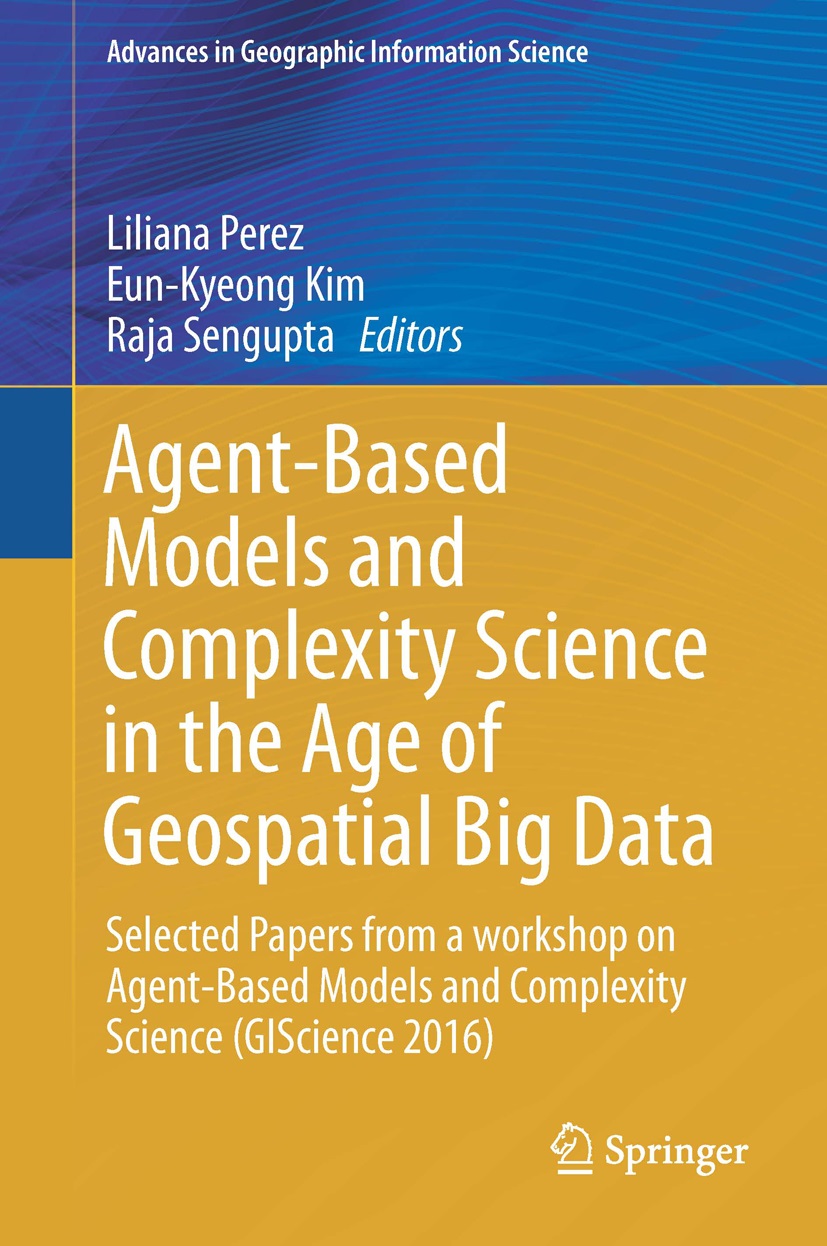Publications
Journal Papers (students underlined):
1. Doodman, S., Mostafavi, M.A., Sengupta, R. and Afghantoloee, A., in press. A Context-Aware Voronoi-based Algorithm for Optimal Placement of Point-based Sensor Networks for Spatiotemporal Field Monitoring. IEEE Sensors. https://doi.org/10.1109/JSEN.2025.3610888
2. Zhang, D., Dub , L., Gieschen, A., Paquet, C. and Sengupta, R., 2025. Quantitative and Spatially Explicit Clustering of Urban Grocery Shoppers in Montreal: Integrating Loyalty Data with Synthetic Population. ISPRS International Journal of Geo-Information, 14(4), p. 159. https://www.mdpi.com/2220-9964/14/4/159.
3. Doodman,
S., Mostafavi, M.A., Sengupta,
R. and Afghantoloee, A., 2025. A
novel Voronoi-driven optimization approach for
point-based sensor network deployment. IEEE Access, 13: 107244-107263.
https:// https://ieeexplore.ieee.org/abstract/document/11045679
4. Sakthivel, P. and Sengupta, R., 2025. Spatial bias in placement of citizen and conventional weather stations and their impact on urban climate research: A case study of the Urban Heat Island effect in Canada. Urban Climate, 59, p.102280. https://doi.org/10.1016/j.uclim.2024.102280
5. Perez, L. and Sengupta, R., 2024. Big Data (R)evolution in Geography: Complexity Modelling in the Last Two Decades. Geography Compass 18:e70009. https://doi.org/10.1111/gec3.70009
6. Burke, R., Sengupta, R., and Ford, A., 2024. A 3D agent-based model for simulating urban densification in Toronto, Canada. Environment and Planning B. https://doi.org/10.1177/23998083241261762
7. Jaber, S., and Sengupta, R., 2024. Spatial and temporal variabilities in land surface temperatures and near-surface air temperatures in an arid to semiarid urban region: implications for urban heat island research. Geo-spatial Information Science. https://doi.org/10.1080/10095020.2024.2310589
8. Dickinson, C., Manaugh, K., Pathak, P. and Sengupta, R., 2024. Geographic identity and perceptions of walkable space. Travel Behaviour and Society, 34, p.100703. https://doi.org/10.1016/j.tbs.2023.100703
9. Sarkar, D., Gogarten, J., Liang, X., Andris, C., Opito, E., Valenta, K., Kalbitzer, U., Sengupta, R. and Chapman, C.A., 2024. Impacts of COVID-19 on biodiversity conservation and community networks at Kibale National Park, Uganda. The Professional Geographer, 76(2): 119-132. https://doi.org/10.1080/00330124.2023.2250416
10. French, M., Patel, A., Qureshi, A., Saxena, D. and Sengupta, R., 2024. Agent-Based Modeling of COVID-19 Transmission: A Case Study of Housing Densities in Sankalitnagar, Ahmedabad. ISPRS International Journal of Geo-Information, 13(6), p.208. https://www.mdpi.com/2220-9964/13/6/208
11. Sengupta, R., Vankeerberghen, G., Wen, R., Rao, J. and Chen, Y., 2023. GIS‐enabled historiography to determine travel routes during the Western Han period via agent‐based models and least‐cost path analysis. Transactions in GIS 27(4): 1090-1103. https://doi.org/10.1111/tgis.13056
12. Huang, Y., Guo, Z., Chu, H. and Sengupta, R., 2023. Evacuation Simulation Implemented by ABM-BIM of Unity in Students Dormitory Based on Delay Time. ISPRS International Journal of Geo-Information, 12(4), p.160. https://www.mdpi.com/2220-9964/12/4/160
13. Jaber, S.M., Abu-Allaban, M.M. and Sengupta, R., 2023. Spatial and temporal patterns of indicators of climate change and variability in the Arab world in the past four decades. Scientific Reports, 13(1), p.15145. https://www.nature.com/articles/s41598-023-42499-y
14. Pathak, P., Pandya, P., Shukla, S., Sane, A., and Sengupta, R., 2022. A Sensor Placement Strategy for Comprehensive Urban Heat Island Monitoring. ISPRS International Journal of Geo-Information. 12(1):11. https://doi.org/10.3390/ijgi12010011
15. Shapla, T. , Myers, M. and Sengupta, R., 2022. Sustainable Land-Use Recommendations in Light of Agroforestry Systems in Response to the Changing Scenario of Land-Cover. Advances in Remote Sensing, 11, 38-48. https://doi.org/10.4236/ars.2022.112003.
16. Fan, J. Y., and Sengupta, R., 2022. Montreal’s Environmental Justice Problem with Respect to the Urban Heat Island Phenomenon. The Canadian Geographer. 66(2):307-321. https://doi.org/10.1111/cag.12690
17. Patel, J., Katan, J., Perez, L., and Sengupta, R., 2021. Transferring decision boundaries onto a geographic space: agent-rules extracted from movement data using classification trees. Transactions in GIS 25(3): 1176-1192. https://doi.org/10.1111/tgis.12770
18. Sarkar, D., Chapman, C., and Sengupta, R., 2021. Mapping research networks supported by the National Geographic Society through spatial social networks. International Journal of Geographical Information Science 35 (12): 2442-2462. https://doi.org/10.1080/13658816.2021.1880588
19. Budhiraja, B., Pathak, P., Agrawal, G., and Sengupta, R., 2021. Satellite and Ground Estimates of Surface and Canopy Layer Urban Heat Island-Comparison and Caveats. International Journal of Applied Geospatial Research 12(4):1-21. https://doi.org/10.4018/ijagr.2021100101
20. Nigam, R., Pandya, K., Alvarinho, L., Sengupta, R., and Kotha, M., 2021. Positive Effects of COVID-19 Lockdown on Air Quality of Industrial Cities - Ankleshwar and Vapi, Gujarat, India. Scientific Reports 11(1): 4285. https://www.nature.com/articles/s41598-021-83393-9
21. Chapman, C.A., Bicca-Marques, J.C., Dunham, A.E., Fan, P., Fashing, P.J., Gogarten, J.F., Guo, S., Huffman, M.A., Kalbitzer, U., Li, B., Ma, C., Matsuda, I., Omeja, P., Sarkar, D., Sengupta, R., Serio-Silva, J.C., Tsuji, Y., and Stenseth, N., 2020. Primates Can Be a Rallying Symbol to Promote Tropical Forest Restoration. Folia Primatologica 91:669 687. https://doi.org/10.1159/000505951
22. Sarkar, D., Chapman, C., Valenta, K., and Sengupta, R., 2019. A Tiered Analysis of Community Benefits and Conservation Engagement from the Makerere University Biological Field Station, Uganda. Professional Geographer 71 (3), 422-436. https://www.tandfonline.com/doi/full/ 10.1080/00330124.2018.1547976
23. Sarkar, D., Andris, C., Chapman, C., and Sengupta, R. 2019. Metrics for characterizing Network Structure and Node Importance in Spatial Social Networks. International Journal of Geographical Information Science 33(5): 1017-1039. https://doi.org/10.1080/13658816.2019.1567736
24. Bonnell, T.R., Ghai, R.R., Goldberg, T.L., Sengupta, R. and Chapman, C.A., 2018. Simulations of environmentally-transmitted parasites under habitat fragmentation suggests that as habitat is lost, its configuration becomes more important. Landscape Ecology 33 (8): 1259-1272. https://doi.org/10.1007/s10980-018-0666-4
25. Chapman, C.A., Bortolamiol, S., Matsuda, I., Omeja, P.A., Paim, F.P., Reyna-Hurtado, R., Sengupta, R. and Valenta, K., 2018. Primate population dynamics: variation in abundance over space and time. Biodiversity and Conservation 27(5): 1221-1238. https://doi.org/10.1007/s10531-017-1489-3
26. MacKenzie, C., S. Moffat, Ogwang, J., Ahabyona, P., and R. Sengupta, 2017. Advocating for Primary Education: Spatial and Temporal Patterns in Enrolment and Exam Achievement in Rural Uganda. Children’s Geographies 15(3): 334-348. https://doi.org/10.1080/14733285.2016.1244603
27. Sakar, D., C.A. Chapman, W. Kagoro, and R. Sengupta, 2016. Countering elephant raiding with SMS: Challenges of deploying public participation based systems in an Information Communication Technologies resource sparse setting. The Canadian Geographer 60(4): 493-504. https://doi.org/10.1111/cag.12314
28. Chapman, C.A., S. Friant, K. Godfrey, C. Liu, V.A.M. Schoof, D. Twinomugisha, J.M. Rothman, D. Sakar, R. Sengupta, K. Valenta, and T.L. Goldberg, 2016. Gastrointestinal parasites influence the social behaviour and network of vervet monkeys (Chlorocebus aethiops). PLoS ONE 11(8): e0161113. https://doi.org/10.1371/journal.pone.0161113
29. Bonnell, T.R., Ghai, R.R., Goldberg, T.L., Sengupta, R. and Chapman, C.A., 2016. Spatial patterns of persistence for environmentally transmitted parasites: Effects of regional climate and local landscape. Ecological Modelling, 338, pp.78-89. https://doi.org/10.1016/j.ecolmodel.2016.07.018
30. Bonnell, T., Chapman, C., and Sengupta, R., 2016. Interaction between scale and scheduling choices in simulations of spatial agents. International Journal of Geographic Information Science, 30(10): 2075-2088. https://doi.org/10.1080/13658816.2016.1158822
31. MacKenzie, C.,
Sengupta, R., and Kaoser,
R., 2015. Chasing Baboons or attending class: protected areas and childhood
education in Uganda. Environmental Conservation, 42(4): 373-383. https://doi.org/10.1017/S0376892915000120
32. Vora, K., Yasobant, S., Sengupta, R., De Costa, A., Upadhyay, A., Mavalankar, D., 2015. Options for Optimal Coverage of Free C-Section Services for Poor Mothers in Indian State of Gujarat: Location Allocation Analysis Using GIS. PLoS ONE 10(9): e0137122. https://doi.org/10.1371/journal.pone.0137122
33. Sarkar, D., Chapman, C., Griffin, L., and Sengupta, R., 2015, Analyzing Animal Movement Characteristics from Location Data. Transactions in GIS 19(4), 516-534. https://doi.org/10.1111/tgis.12114
34. Benessaiah, K., and Sengupta, R., 2014, How is Shrimp Aquaculture Transforming Coastal Livelihoods and Lagoons in Estero Real, Nicaragua? The Need to Integrate Social Ecological Research and Ecosystem-Based Approaches. Environmental Management 54(2): 162-179. https://doi.org/10.1007/s00267-014-0295-x
35. O Farrill, G., Gauthier-Schampaert, K., Rayfield, B., Bodin, O., Calm , S., Sengupta, R., and Gonzalez, A., 2014. The Potential Connectivity of Waterhole Networks and the Effectiveness of a Protected Area under Various Drought Scenarios. PLoS ONE. https://doi.org/10.1371/journal.pone.0095049
36. Bonnell, T.R.,
Campenni, M., Chapman, C., Gogarten,
J., Reyna-Hurtado, R., Teichroeb, J., Wasserman, M., and Sengupta,
R., 2013. Emergent group
level navigation: an agent-based evaluation of movement patterns in a folivorous primate.
PLoS ONE. https://doi.org/10.1371/journal. pone.0078264
37. Bonnell, T.R., Dutilleul, P., Chapman, C. A., Reyna-Hurtado, R., Hernandez-Sarabia, R.U., Sengupta, R., 2013. Analysing small-scale aggregation in animal visits in space and time: the ST-BBD method. Animal Behaviour 85(2): 483-492. https://doi.org/10.1016/j.anbehav.2012.12.014
38. Chapman, C.A., T.R. Bonnell., R. Sengupta., T.L. Goldberg, and J.M. Rothman, 2013. Is Markhamia lutea’s abundance determined by animal foraging? Forest Ecology and Management 308: 62-66. https://doi.org/10.1016/j.foreco.2013.07.052
39. Mala, S., and R. Sengupta, 2013. Geo-visual approach for spatial scan statistics: an analysis of dengue fever outbreaks in Delhi. International Journal of Advanced Computer Science and Applications 4(10):127-137.
40. MacKenzie, C., Chapman, C., and Sengupta, R., 2012, Spatial patterns of illegal resource extraction in Kibale National Park, Uganda. Environmental Conservation 39(1): 38-50. https://doi.org/10.1017/S0376892911000282
41. O Farrill, G., Calme, S., Sengupta, R., and Gonzalez, A., 2012. Effective dispersal of large seeds by Baird's tapir: a large-scale field experiment. Journal of Tropical Ecology 28(1): 119-122. https://doi.org/10.1017/S0266467411000599
42. Heller, E., Rhemtulla, J.M., Lele, S., Kalacska, M., Badiger, S., Sengupta, R., Ramankutty, N., 2012. Mapping Irrigated Areas and Cropping Intensities: the contribution of Multi-season data in highly heterogeneous regions of Southern India. Photogrammetric Engineering and Remote Sensing 78(8): 815-827. https://doi.org/10.14358/PERS.78.8.815
43. Samal, A.R., Sengupta, R., and Fifarek, R., 2011, Modeling spatial anisotropy of gold concentration data using GIS-based interpolated maps and variogram analysis: implications for structural control of mineralization. Journal of Earth System Science 120(4): 583-594. https://doi.org/10.1007/s12040-011-0091-4
44. Bonnell, T., Sengupta, R., Chapman, C., and Goldberg, T., 2010, An agent-based model of red colobus resources and disease dynamics implicates key resource sites as hot spots of disease transmission Ecological Modelling 221(20): 2491-2500. https://doi.org/10.1016/j.ecolmodel.2010.07.020
45. Jacob, A.L., Vaccaro, I., Sengupta, R., Hartter, J., and Chapman, C.A., 2008. Integrating landscapes that have experienced rural depopulation and ecological homogenization into tropical conservation planning. Tropical Conservation Science 1(4): 307-320. https://doi.org/10.1177/194008290800100402
46. Jackson, J., Forest, B., and Sengupta, R., 2008. Agent-Based Simulation of Urban Residential Dynamics and Land Rent Change in a Gentrifying Area of Boston. Transactions in GIS, 12(4): 475-491. https://doi.org/10.1111/j.1467-9671.2008.01109.x
47. Sengupta, R., Rosenshein, L., Gilbert, M., and Weiller, C., 2007, Ecoregional Dominance in Spatial Distribution of Avian Influenza (H5N1) Outbreaks [letter]. Emerging Infectious Diseases, 13(8): 1269-1271. https://pmc.ncbi.nlm.nih.gov/articles/PMC2828375/
48. Sengupta, R., and Sieber, R., 2007, Geospatial Agents, Agents Everywhere.... Transactions in GIS, 11(4): 483 -506. https://doi.org/10.1111/j.1467-9671.2007.01057.x
49. Sengupta, R, Lant, C., Kraft, S., Beaulieu, J., Peterson, W., and Loftus, T., 2005, Modeling CRP Enrolment using Agents within Spatial Decision Support Systems: An Example from Southern Illinois. Environment and Planning B, 32(6): 821-834. https://doi.org/10.1068/b31193
50. Sengupta, R., Middleton, B., Chen, Y., Zuro, M., and Hartman, H., 2005, Propagule deposition and landscape characteristics of source forests of Rhizophora mangle in coastal landscapes in Florida. Landscape Ecology, 20 (1): 63-72. https://doi.org/10.1007/s10980-004-0468-8
51. Most, M., Sengupta, R., and Burgener, M., 2004, Spatial Scale and Population Assignment Choices in Environmental Justice Analyses. The Professional Geographer 56(4): 574-586. https://doi.org/10.1111/j.0033-0124.2004.00449.x
52. Heine, R., Lant, C., and Sengupta, R., 2004, Development and Comparison of Approaches for Automated Extraction of Stream Channel Networks. Annals of the Association of American Geographers, 94(3): 447-490. https://doi.org/10.1111/j.1467-8306.2004.00409.x
53. Sengupta, R., and Chen, Y., 2004, Hybrid Spatio-Temporal Data Model and Structure (HST-DMS) for Efficient Storage and Retrieval of Land Use Information. Transactions in GIS, 8(3): 351-366. https://doi.org/10.1111/j.1467-9671.2004.00187.x
54. Larson, B., and Sengupta, R., 2004. A Spatial Decision Support System to Identify Species-Specific Critical Habitats Based on Size and Accessibility using US GAP Data. Environmental Modelling and Software, 19(1): 7-18. https://doi.org/10.1016/S1364-8152(03)00098-7
55. Sengupta, R., and Bennett, D., 2003. Agent-based Modeling Environment for Spatial Decision Support. International Journal of Geographical Information Science, 17 (2): 157-180. https://doi.org/10.1080/713811747
56. Sengupta, R., Bennett, D. A., Kraft, S. E., and Beaulieu, J., 2000. Evaluating the Impact of Policy-induced Landuse Management Practices on Non-point Source Pollution using a Spatial Decision Support System: A simulation of the Big Creek Basin. Water International, 25 (3): 437-445. https://doi.org/10.1080/02508060008686851
Editorials:
1. Sengupta,
R., 2007, Topic 2: Applied Models and Decision Support Systems (DSS). Water
International, 32(3): 395-396.
2. Sengupta,
R., 2006, Water International: A look at the past, present and future. Water
International, 31(3): 287.
Book Chapters:
1. Doodman, S., Mostafavi, M.A. and Sengupta, R., 2023. Towards Integration of Spatial Context in Building Energy Demand Assessment Supported by CityGML Energy Extension. In International Symposium on Web and Wireless Geographical Information Systems (Mostafavi, M.A., and Del Mondo, G., Eds) (pp. 19-36). Cham: Springer Nature Switzerland.
2. Sengupta, R., Chapman, C.C., Sarkar, D., and Bortolamiol, S., 2017. Automated Extraction of Movement Rationales for Building Agent-Based Models: Example of a Red Colobus Monkey Group. In Agent-Based Models and Complexity Science in the Age of Geospatial Big Data. Perez, L., Kim, E.K., and Sengupta, R. (eds). Advances in Geographic Information Science Series. Springer International Publishing, Zurich, Switzerland.
3. Deshpande, S., and Sengupta, R., (2017). Animating Maps: Visual Analytics meets Geoweb 2.0. In Advances in Geocomputation (Geocomputation 2015: The 13th International Conference), Dallas, TX, USA. Griffith, D.A., Chun, Y., and Dean, D. (eds). Advances in Geographic Information Science Series Vol. 10: 75-84. Springer, Cham, Switzerland.
4. Sarkar, D.,Sieber, R., and Sengupta, R., (2016). GIScience Considerations in Spatial Social Networks. In GIScience 2016: Proceedings of the 9th International Conference on Geographic Information Science), Montreal, QC, Canada. Miller, J., O Sullivan, D., and Wiegand, N. (eds). Lecture Notes in Computer Science Vol. 9927:85-100. Springer, Berlin, Germany.
5. Chapman, C.A., Twinomugisha, D., Teichroeb, J.A., Valenta, K., Sengupta, R., Sarkar, D. and Rothman, J.M., 2016. How Do Primates Survive Among Humans? Mechanisms Employed by Vervet Monkeys at Lake Nabugabo, Uganda. In Ethnoprimatology (pp. 77-94). Springer International Publishing, Zurich, Switzerland.
6. Chapman, C.A., Huffman, M.A., Ryan, S.J., Sengupta, R. and Goldberg, T., 2008. Ways forward in the study of primate parasite ecology. In Primate parasite ecology: the dynamics and study of host-parasite relationships. Huffman, M.A. and Chapman, C.A. (eds). Cambridge Studies in Biological and Evolutionary Anthropology pp. 487-505 [ISBN 978 0 521 87246 1]. Cambridge University Press, UK.
7. Sengupta, R., 2006. Simulation Modelling within Collaborative Spatial Decision Support Systems using cause-effect models and Software Agents. In Collaborative GIS (S. Dragicevic and S. Balram, Eds.) pp. 134-149 [ISBN 1-5914-0846-6]. Idea Group Publishing, Hershey, PA.
8. Samal, A.R., Fifarek, R., and Sengupta, R., 2005. Geostatistical Investigation of Elemental Enrichment in Hydrothermal Deposits. In Quantitative Geology and Geostatistics, Vol. 14 (O. Leuangthong and C.Deutsch, Eds.) pp. 491-500 [ISBN: 1-4020-3515-2]. Springer: New York, NY.
9. Sengupta, R., and Bennett, D. A., 2001. Making Data Rich Depositories of Geographical Data Usable with Intelligent System Technologies. In Geographic Data Mining and Knowledge Discovery (H. Miller and J. Han, Eds.). pp. 110-128. [ISBN: 0-4152-3369-0]. Taylor and Francis: Levittown, PA.
10. Bennett, D. A., Sengupta, R., Beaulieu, J., and Kraft, S. E., 2000. Integrating Simulation Models and Geographic Information For Environmental Problem Solving. In Spatial Information for Landuse Management (Michael. J. Hill and Richard J. Aspinall, Eds.) [ISBN: 9-0569-9315-1]. whitewell Publishers: whitewood, NJ.
11. Bennett, D. A., Wade, G. A., and Sengupta, R., 1999. Geographical Modeling in Heterogeneous Computing Environments. In Interoperating Geographic Information Systems (M. Goodchild, M. Egenhofer, R. Fegeas, and C. Kottman, Eds.) [ISBN: 0-7923-8436-9]. Kluwer Academic Publishers: Dordrecht, Netherlands.
Book Reviews:
1. Sengupta,
R., 2003: Review of World Water and Food to 2025: Dealing with Scarcity.
Mark W. Rosegrant, Ximing Cai and Sarah A. Cline. Washington
DC, USA: International Food Policy Research Institute. 2002. 322 pp. Water
International, 28(1): 132-133.
Refereed Conference Proceedings:
1. Gieschen, A., Sengupta, R., Zhang, D., Belkhiria, F., Brown, S.T., Paquet, C., and Dube, L., 2025. SynthEco: An open-source Python application for the generation of a multi-scale digital ecosystem anchored in synthetic populations. Proceedings of the Practice and Experience in Advanced Research Computing 2025 (PEARC 2025). https://dl.acm.org/doi/full/10.1145/3708035.3736059
2. Shukla, S., Kale, S., Sengupta, R., and Pathak, P., 2025. Spatial distribution and coverage of green spaces. Proceedings of the ISPRS Geospatial Innovation Frontier Technologies Sustainability (GIFTS) Summit, Pune, India.
3. Patel, J., Dickinson, C., Sengupta, R. and Sarkar, D., 2023. Intrinsic data quality of corporate contributions to OpenStreetMap: Assessing completeness. Proceedings of Spatial Knowledge & Information (SKI) Conference, Banff, Alberta, Canada.https://www.researchgate.net/profile/Daniel-Romm-2/publication/369110146_Platial_Rhythm/links/6409fe86bcd7982d8d6e916e/Platial-Rhythm.pdf#page=104
4. Dube , L., Gieschen, A., Sengupta , R., Rosenblatt, A., Silveira , P., Paquet, C. & Brown, S., 2023, SynthEco: A digital system for analyzing the brain-to-society mechanisms of lifecourse human behavior in its multi-layered and dynamic environment and its mental health and well-being consequences. HIBALL 7th BigBrain Workshop: Challenges of big data integration. 6 Oct 2023 Gr ska Innovation and business growth center, Reykjav k, Iceland.
5. Gieschen, A., Paquet, C., Sengupta, R., Aunio, A.L., Belkhiria, F., Brown, S. and Dube, L., 2023. SynthEco-A multi-layered digital ecosystem for analysing complex human behaviour in context. International Journal of Population Data Science, 8(3)
6. Belkhiria, F., Nie, J. Y., Paquet, C., Sengupta, R., Gieschen, A., Talukder, B., Brown, S. & Dub , L., 2022. Using Big Data and Machine Learning for Multilayered Surveillance for Healthy Food Environment and Diet. In 2022 IEEE International Conference on Big Data (pp. 4055-4064). IEEE. https://ieeexplore.ieee.org/document/10020762.
7. Pathak, P., Buddhiraja, B., Sengupta, R., 2019. Inverted Surface UHI: An artefact of relying solely on Satellite Remote Sensing data for measuring the Urban Heat Island Phenomenon. Proceedings of the 5th International Conference on Countermeasures to Urban Heat Islands (IC2UHI 2019), (2-4 Dec, 2019; International Institute of Information Technology-Hyderabad, India).
8. Yadav, P., Deshpande, S., and Sengupta, R., 2015. Animating Maps: Visual Analytics meets Geoweb 2.0. Geocomputation 2015: Proceedings of the 13th International Conference on GeoComputation. Dallas, TX: Department of Geospatial Information Sciences, University of Texas-Dallas (21 May 2015).
9. Hughes, C., Sengupta, R., Naik, V., and Saxena, D., 2014. Geovisualization for cluster detection of Hepatitis A & E outbreaks in Ahmedabad, Gujarat, India. Proceedings of the Third ACM SIGSPATIAL International Workshop on the use of GIS in Public Health. Dallas, TX: Dept. Of Geography, Texas A&M University (4 November, 2014).
10. Koti, S.R., and Sengupta, R., 2012, Distributed Web Processing Service (DWPS) for Real Time Analysis of Health Data. Proceedings of GIScience 2012. Columbus, Ohio: Dept.of Geography, The Ohio State University (18-21 September, 2012).
11. Bonnell, T.R., R. Sengupta, C. A. Chapman and T. L. Goldberg, 2011, Linking landscapes to disease: An agent-based model simulating the impact of forest composition on spread of disease in red colobus populations. Proceedings of ICA-ISPRS 2011 Joint Workshop, Burnaby, Canada (10-12 August, 2011).
12. Bonnell, T., Sengupta, R., and Chapman, C., 2011, Spatial Epidemiology and GIS/ABM: a case study of the red colobus monkey. Spatial Knowledge and Information (SKI) Canada: Fernie, BC, Canada (4-6 March, 2011).
13. Sengupta, R., and Bonnell, T., 2008, Emerging Infectious Diseases and Agent-based Models: Moving Epidemiology from Analyzing Pattern to Simulating Process. Spatial Knowledge and Information (SKI) Canada, Fernie, BC, Canada (15-17 Feb, 2008).
14. Samal, A.R., Fifarek, R., and Sengupta, R., 2005. The Spatial Pattern of Trace Elements Relative to Gold Concentrations in an Epithermal Gold Deposit . Proceedings of IAMG 05: GIS and Spatial Analysis (Vol. 1: p. 458-463), Toronto, Canada: International Association for Mathematical Geology, Kingston, Ontario, Canada.
15. Sengupta, R., Beaulieu, J., and Kraft, S., 2003, Assisting Decision-Makers Manage Compensatory Payments to Preserve Water Quality in Agricultural Watersheds through modeling and simulation . Proceedings of the XIth World Water Congress, Madrid, Spain (11th-9th October, 2003): International Water Resources Association, Carbondale, Illinois 62901, USA.
16. Sengupta, R., Beaulieu, J., Kraft, S., Loftus, L., Shcherbanuik, M., and Soman, S., 2002, Modeling Trade-Offs between Water Quality and Profits in Agricultural Watersheds . Proceedings of Water for Human Survival: IWRA Regional Conference, New Delhi, India: Central Board of Irrigation and Power, Malcha Marg, New Delhi 110 021, India.
17. Sengupta, R., Loftus, T., and Shcherbaniuk, M., 2002. Agent-based modeling of human decision-making behavior within Spatial Decision Support Systems . Proceedings of GIScience 2002: Second International Conference on Geographic Information Science, Boulder, CO: National Center for Geographic Information Analysis (NCGIA), University of California-Santa Barbara, CA.
18. Radhakrishnan, P., and Sengupta, R., 2002. Groundwater modeling in GIS by integrating ArcView 3.2, MODFLOW and MODPATH . Proceedings of the 2002 ESRI Users Conference, San Diego, CA: ESRI Inc, Redlands, California, USA.
19. Sengupta, R., Bennett, D., and Armstrong, M. P., 2000, Agent-oriented Modeling Environment for Spatial Decision Support . Proceedings of GIScience 2000: First International Conference on Geographic Information Science, Savannah, GA: National Center for Geographic Information Analysis (NCGIA), University of California-Santa Barbara, CA, USA.
20. Armstrong, M. P., Bennett, D., Densham, P., and Sengupta, R., 2000, Theoretical Perspectives on Agent-Oriented Geographic Information Management and Analysis . Proceedings of GIScience 2000: First International Conference on Geographic Information Science, Savannah, GA: National Center for Geographic Information Analysis (NCGIA), University of California-Santa Barbara, CA, USA.
21. Wade, G.A., Bennett, D., and Sengupta, R., 1997. An interactive distributed architecture for geographical modeling . Proceedings of Auto-Carto 13, Seattle, WA: American Congress on Surveying and Mapping, Bethesda, MD, USA.
22. Sengupta, R., and Bhattacharya, S., 1997. Zip codes for direct marketing modeling using GIS . Proceedings of AIS 97 Americas Conference, Indianapolis, IN: Association of Information Systems, Atlanta, GA, USA.
23. Sengupta, R., Bennett, D., and Wade, G., 1996. Agent mediated links between GIS and spatial modeling software using a model definition language . Proceedings of GIS/LIS 96, Denver, CO: American Congress on Surveying and Mapping, Bethesda, MD, USA.
Conference and Invited Presentations (including student-led presentations):
1. Sengupta, R., Sakthivel, P., Xiong, S., and Zhu, J., 2025. Intra-city variability of the Urban Heat Island phenomenon: evidence from citizen science sensing. Presented on May 21st, 2025 at the Canadian Association of Geographers Annual Meeting, Ottawa, ON.
2. Sengupta, R., and Harati Asl, S., 2025. Why overthink Mobility in Agent-Based Models when optimization works? Presented on March 27th, 2025 at the Association of American Geographers Annual Meeting, Detroit, MI, USA.
3. Sengupta, R., Lam, A., and Sakthivel, P., 2024. Understanding the impact of green spaces on Urban Heat Island (UHI) intensity needs all the IoT support it can get. Presented on March 12th, 2024 at the Department of Geomatics Engineering, University of Calgary, Calgary, AB, Canada.
4. Sengupta,
R., Lam, A., and Sakthivel, P., 2024. Impact of urban green spaces on
Urban Heat Island (UHI) intensity. Presented on 3
Sept, 2024 at Soup and Science, organized by Faculty of Science, McGill
University.
5. Sengupta, R., Lam, A., and Sakthivel, P., 2024. Urban Heat Islands (UHI). Presented on 7 Aug, 2024 at School of Economics, Symbiosis International University, Pune, Maharastra, India.
6. Sengupta, R., Lam, A., and Sakthivel, P., 2023. Scale impacts of Greenspace composition on Urban Heat Islands (UHI). Presented on August 11th, 2023 at the Transportation Research and Injury Prevention Center (TRIP), Indian Institute of Technology-Delhi (IIT-Delhi), Delhi, India.
7. Sengupta, R., Lam, A., and Sakthivel, P., 2023. Utilisation des capteurs de temp rature pour mesurer l intensit des lots de chaleur. Presented on November 21st, 2023 at the Table des urbanistes de l Ouest-de-l le meeting, held at Dollard-des-Ormeaux community center, DDO, QC.
8. Zhang, D., and Sengupta, R., 2023. Integrating reinforcement learning into agent-based model for simulating the grocery stores choices of urban customers. GIScience 2023, Leeds UK (Poster).
9. Sengupta, R., Vankeerberghen, G., Wen, R., Rao, J., and Chen, Y., 2023. Retracing of historical routes using Agent-Based Models (ABMs) : An example from the western Han period of Chinese History. GIScience 2023, Leeds UK (Poster).
10. Vankeerberghen, G., and Sengupta, R., 2022. Representing the Mobility of Historical Agents through Digitization and Topographic Path Finding : the Diary of Shi Rao (d. 10 BCE). Presented online on March 31st, 2022 at the Indian Ocean World Centre, McGill University, Winter 2022 Speaker Series.
11. Vankeerberghen, G., and Sengupta, R., 2022. Representing the Mobility of Historical Agents through Digitization and Topographic Path Finding : the Diary of Shi Rao (d. 10 BCE). Invited keynote presented online on June 25th, 2022 at the Digital Orientalist Conference (https://digitalorientalist.com/).
12. Vankeerberghen, G., and Sengupta, R., 2021. Representing the Mobility of Historical Agents through Digitization, Topographic Path Finding and Dynamic Visualization: the Case of the Western Han Nobles. Presented online on Nov 9th 2021 at the Digital Empires Virtual Lecture organized by the Liu Institute for Asia & Asian Studies and the Department of History, University of Notre Dame, Notre Dame, US.
13. Sengupta, R., 2020. It's Complex: Future of Modelling and Simulation in a Changing Geospatial Data Environment. Presented online on Sept 22nd 2020 at Waterloo Institute for Complexity and Innovation Seminar Series, University of Waterloo, Waterloo, Canada.
14. Sengupta, R., 2020. Geospatial Technologies for Decision Environments: Current and Future Opportunities. Presented on Feb 6th 2020 at BtS Research Seminar, McGill Center for the Convergence in Health and Economics (MCCHE), McGill University, Montreal, Canada.
15. Sengupta, R., 2019. Urban Heat Island effect and building energy demand: linkages explained using a dense, low cost sensor network . Presented on June 25th 2019 at Center for Zero Energy Building Studies (CZEBS), Dept of Building, Civil and Environmental Engineering, Concordia University, Montreal, Canada.
16. Sengupta, R., 2019. Predicting Movement: A case for machine learning possible pathways for mobile agents . Presented on 31st July 2019 at Dept. of Computer Science, BITS Pilani Goa Campus, Goa, India.
17. Sengupta, R., 2019. GIS and Sensors as tools to analyze Spatial Patterns of Urban Heat Island (UHI) effect . Presented on 31st July 2019 at Dept of Geology, Goa University, Goa, India.
18. Sengupta, R., Pathak, A., and Buddhiraja, B., 2019. Estimating UHI from Remote Sensing and Weather Stations: Some Caveats. American Association of Geographers Meeting (2019), 3 Apr, Washington, DC, USA.
19. Sengupta, R. and Perez, L., 2018. Big Data (r)evolution in ABM and Complexity Science. In Workshop W5: Rethinking the ABCs: Agent-Based Models and Complexity in the age of Big DataAgent-Based Models and Complexity Science , GIScience 2018, 28 Aug, Melbourne, VIC, Australia.
20. Sengupta, R., 2018. Manipulating objects to cultivate fields: A Spatio-Temporal Data Structure for Sensor placements to measure the Urban Heat Island phenomenon. GIScience 2018, 29 Aug, Melbourne, VIC, Australia.
21. Pathak, P.A. and Sengupta, R., 2017. Urban Heat Island (UHI) Effect in the context of urban matrix: evaluation with ground-based, low cost sensors. Annual Meeting of the Association of American Geographers: 5-9 April, Boston, MA, USA.
22. Sengupta, R., 2015. Adding time to space: Models and GIS . Invited Presentation, TERRA Guest Lecture Series, Dept. of Geology, St. Xavier s College, University of Mumbai, Mumbai, India. (July 17, 2015).
23. Sengupta, R., and Bonnell, T., 2014, What s so Special about Spatial Agents? . Annual Meeting of the Association of American Geographers: 8-11 April, Tampa, FL, USA.
24. Bonnell T., Sengupta, R, Chapman, C., and Goldberg, T., 2012, Linking Landscapes to Disease: An Agent-Based Model simulating the impact of forest composition on spread of disease in red colobus populations . Annual Meeting of the Association of American Geographers: 24-28 February, New York, USA.
25. Bonnell, T., Sengupta, R., and Chapman, C., 2011, Spatial Epidemiology and GIS/ABM: a case study of disease transmission amongst Red Colobus monkeys . Annual Meeting of the Association of American Geographers: 12-16 April, Seattle, USA.
26. Sengupta, R., 2010, Spatial Technologies for e-Governance. Invited Presentation, Indian Institute for Public Administration, New Delhi, India (April 13, 2010).
27. Sengupta, R., 2010, Integrating spatially-explicit human decisions with GIS: An agent-based approach. Invited Presentation, Centre for the Study of Regional Development, Jwaharlal Nehru University, New Delhi, India (January 22, 2010).
28. Sengupta, R., Bonnell, T., and Chapman, C., 2009. Simulating Parasite-Host Interactions using Agent-Based Models: A Case-Study of Kibale National Park, Uganda. Annual Meeting of the Association of American Geographers: 22-27 March, Las Vegas, USA.
29. Sengupta, R., 2009, Integrated Spatial Modelling and Geoinformatics: Emerging and Essential tool for Understanding Complex Environmental Dynamics. Invited Presentation, Ashoka Trust for Research in Ecology and Environment, Bengaluru, Karnataka, India (July 1, 2009).
30. Bonnell T., Chapman, C., and Sengupta, R., 2009 Linking landscapes to disease: red colobus foraging behaviour and its implications for the spread of disease in logged forests. Quebec center for Biodiversity Science: Nov 30 Dec 2, Montreal, Quebec, Canada
31. Sengupta, R., 2007, Application of Geographic Information Science in Natural & Social Science Research. Invited Presentation, Institute for Social and Economic Change, Bengaluru, Karnataka, India (June 4, 2007).
32. Sengupta, R., 2006, Agents in a Virtual Watershed: Modeling agricultural policy response. Presented at the Annual Meeting of the Association of American Geographers, Chicago, IL (March 7-11, 2006).
33. Sengupta, R., 2005, CRP Adoption using agents: the Virtual Watershed Project. Presented at the West Lakes Division Meeting, Association of American Geographers, Iowa City, IA (November 3-5, 2005).
34. Sengupta, R., 2004. Modeling Adoption of Conservation Cover Programs using Software Agents . Presented at the Canadian Association of American Geographers Annual Meeting, Moncton, NB, Canada.
35. Sengupta, R., 2004, Spatial Decision Support Systems and Agents: Modelling meets Social Science. Invited Presentation, Department of Geography, Universite de Montreal, Montreal, Quebec, Canada (Nov 30, 2004).
36. Sengupta, R., and Sieber, R., 2004. Agent, Agents Everywhere Presented at the Association of American Geographers Annual Meeting, Philadelphia, PA, USA.
37. Sengupta, R., 2003. Modeling Acceptance of Ecosystem Service Payments in Decision-Support Systems using Software Agents . Presented at the 2003 Open Meeting of the Human Dimensions of Global Environmental Change Research Community, Montreal, Canada.
38. Sengupta, R., Loftus, T., and Shcherbanuik, M., 2003. Agent-based modeling of human decision-making behavior within Spatial Decision Support Systems . Presented at the Association of American Geographers Annual Meeting, New Orleans, LA, USA.
39. Sengupta, R., 2002. Assisting decision-makers manage CRP payments in agricultural watersheds through modeling and simulation . Presented at the Association of American Geographers Annual Meeting, Los Angeles, CA, USA.
40. Sengupta, R., Radhakrishnan, P., Loftus, T., and Bennett, D., 2001, SARs: Software Agents that represent stakeholders at the bargaining table . Presented at the Association of American Geographers Annual Meeting, New York City, NY, USA.
41. Sengupta, R., and Bennett, D., 2000, Analysis on a platter: agents that assist in the integration of data and analytical tools . Presented at the Association of American Geographers Annual Meeting, Pittsburgh, PA, USA.























